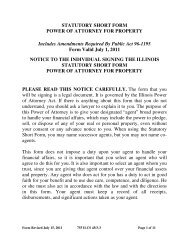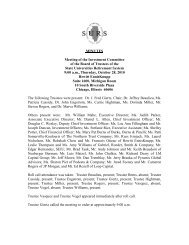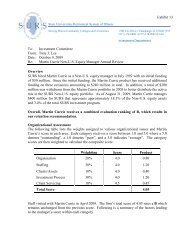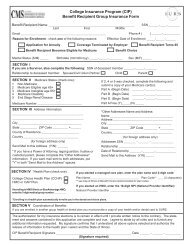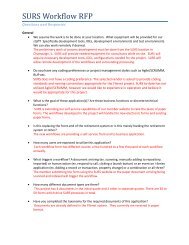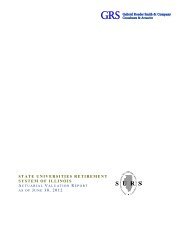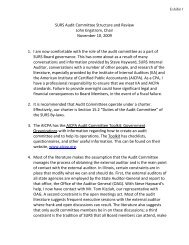SPECIAL TAX NOTICE REGARDING YOUR ROLLOVER ... - SURS
SPECIAL TAX NOTICE REGARDING YOUR ROLLOVER ... - SURS
SPECIAL TAX NOTICE REGARDING YOUR ROLLOVER ... - SURS
You also want an ePaper? Increase the reach of your titles
YUMPU automatically turns print PDFs into web optimized ePapers that Google loves.
If you roll over your payment to a Roth IRA<br />
You can roll over a payment from the Plan made before January 1, 2010 to a Roth IRA only if your<br />
modified adjusted gross income is not more than $100,000 for the year the payment is made to you and, if<br />
married, you file a joint return. These limitations do not apply to payments made to you from the Plan after<br />
2009. If you wish to roll over the payment to a Roth IRA, but you are not eligible to do a rollover to a Roth<br />
IRA until after 2009, you can do a rollover to a traditional IRA and then, after 2009, elect to convert the<br />
traditional IRA into a Roth IRA. The Plan administrator is not responsible for verifying your eligibility to<br />
make a rollover to a Roth IRA. (IRS Notice 2008-30)<br />
If you roll over the payment to a Roth IRA, a special rule applies under which the amount of the payment<br />
rolled over (reduced by any after-tax amounts) will be taxed. However, the 10% additional income tax on<br />
early distributions will not apply (unless you take the amount rolled over out of the Roth IRA within 5<br />
years, counting from January 1 of the year of the rollover). For payments from the Plan during 2010 that<br />
are rolled over to a Roth IRA, the taxable amount can be spread over a 2-year period starting in 2011.<br />
If you roll over the payment to a Roth IRA, later payments from the Roth IRA that are qualified<br />
distributions will not be taxed (including earnings after the rollover). A qualified distribution from a Roth<br />
IRA is a payment made after you are age 59½ (or after your death or disability, or as a qualified first-time<br />
homebuyer distribution of up to $10,000) and after you have had a Roth IRA for at least 5 years. In<br />
applying this 5-year rule, you count from January 1 of the year for which your first contribution was made<br />
to a Roth IRA. Payments from the Roth IRA that are not qualified distributions will be taxed to the extent<br />
of earnings after the rollover, including the 10% additional income tax on early distributions (unless an<br />
exception applies). You do not have to take required minimum distributions from a Roth IRA during your<br />
lifetime.<br />
You cannot roll over a payment from the Plan to a designated Roth account in an employer plan.<br />
For more information, see IRS Publication 590, Individual Retirement Arrangements (IRAs). You should<br />
consult your tax advisor if you are interested in rolling over your distribution to a Roth IRA.<br />
If you are an eligible retired public safety officer and your pension payment is used to pay for health<br />
coverage or qualified long-term care insurance<br />
If you retired as a public safety officer and your retirement was by reason of disability or was after normal<br />
retirement age, you can exclude from your taxable income plan payments paid directly as premiums to an<br />
accident or health plan (or a qualified long-term care insurance contract) that your employer maintains for<br />
you, your spouse, or your dependents, up to a maximum of $3,000 annually. For this purpose, a public<br />
safety officer is a law enforcement officer, firefighter, chaplain, or member of a rescue squad or ambulance<br />
crew.<br />
If you are not a plan member<br />
Payments after death of the member. If you receive a distribution after the member’s death that you do not<br />
roll over, the distribution will generally be taxed in the same manner described elsewhere in this notice.<br />
However, the 10% additional income tax on early distributions and the special rules for public safety<br />
officers do not apply, and the special rule described under the section “If you were born on or before<br />
January 1, 1936” applies only if the member was born on or before January 1, 1936.<br />
If you are a surviving spouse. If you receive a payment from the Plan as the surviving spouse of a<br />
deceased member, you have the same rollover options that the member would have had, as<br />
described elsewhere in this notice. In addition, if you choose to do a rollover to an IRA, you may<br />
treat the IRA as your own or as an inherited IRA.




